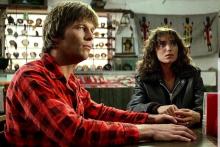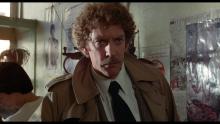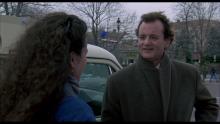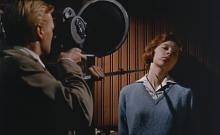The following notes on Starman were written by Madison Barnes-Nelson, PhD student in the Department of Communication Arts at UW Madison. A 35mm print of Starman will screen at the Chazen Museum of Art on Sunday, February 25, at 2 p.m. The screening is the first of three movies in the series "Cinematic Messages from Our Planet," all presented in conjunction with the currently-on-view Chazen exhibit, "Message from Our Planet." The Chazen is located at 750 University Avenue. Admission to the exhibit and the Starman screening is free!
By Madison Barnes-Nelson
Part road movie, part romance, part melancholic science fiction, John Carpenter’s Starman is, at its core, a film about the search for hope and connection in the aftermath of tragedy. Jeff Bridges plays the titular Starman, an alien, who, after crash landing on Earth in rural Wisconsin, takes the bodily form of Scott, the late husband of grief-stricken widow Jenny Hayden (Karen Allen). What follows is surprisingly sweet and sincere romantic drama from Carpenter, who is primarily known for his cynical, hard-edged genre films such as Assault on Precinct 13 (1976), Halloween (1978), and Escape from New York (1981).
Starman spent five years in development at Columbia Pictures and was repeatedly delayed due to the studio’s commitment to a project called Night Skies, a quasi-sequel to Close Encounters of the Third Kind (1977) from director Steven Spielberg and writer John Sayles. Night Skies was re-written by Melissa Mathison in 1981 as E.T. and Me, later re-titled as E.T. The Extra Terrestrial. Columbia rejected E.T., calling it a “kid’s picture,” and the film moved to Universal, later becoming the highest-grossing film in history at the time of its release in 1982. After fumbling E.T., Columbia re-focused attention to the more adult-themed Starman, with Michael Douglas serving as executive producer and star and famed 70s and 80s Hollywood screenwriter and script doctor Dean Riesner, known for his collaborations with Clint Eastwood and Don Siegel, set to write the screenplay.
The film passed through many directors before landing in John Carpenter’s lap, including Adrian Lyne, Mark Rydell, John Badham, Tony Scott, and Peter Hyams. Riesner would end up writing a total of seven different drafts of the film, with an assist from screenwriting duo Edward Zwick and Diane Thomas (Romancing the Stone), who did uncredited rewrites on the final script. Eventually, Carpenter came on board, hoping for the chance to do a sci-fi film with elements of the screwball romantic comedy It Happened One Night (1934), a major departure from his “thriller-exploitation image.” While working with Carpenter, Riesner shifted focus from the science fiction storyline, instead writing “a ‘Getting to Know You On the Run’ kind of picture, like The 39 Steps and The Defiant Ones, only now it was about a girl and an alien.” Somewhat bafflingly, the final screenplay is not credited to Riesner. Instead, The Writer’s Guild of America arbitrated that Bruce A. Evans and Raynold Gideon, who originated the story and wrote two early drafts, would receive sole writing credit. However, Carpenter himself has publicly acknowledged Riesner for developing the actual shooting script for the film and received a special dedication in the film’s credits.
After Michael Douglas dropped out the film (though retaining an executive producer credit), Kevin Bacon was briefly attached to play Starman/Scott. However, according to a making-of documentary, Jeff Bridges was John Carpenter’s and script supervisor Sandy King’s choice to play Starman, not only because of his charismatic, masculine persona he had built up in films such as The Last Picture Show (1972) and Thunderbolt and Lightfoot (1975), but also after seeing his original, method-like approach to playing the title character. To create Starman, Bridges turned to real-life friends who he “always thought seemed like they came from outer space.” He was particularly inspired by friend and dancer Russell Clark, rehearsing extensively with him to nail down Starman’s strange bodily movements when he mimics a video of the deceased Scott. Bridges even studied his own newborn daughters, watching “their newness, and the way they would look at the world, their perception of things.” The New York Times’ Janet Maslin highlighted the performance in her review, calling it “a fine showcase for the actor’s blend of grace, precision, and seemingly offhanded charm.”
Carpenter also sought out Karen Allen, who had broken out in National Lampoon’s Animal House (1978) and later achieved international fame as Marion Ravenwood in Raiders of the Lost Ark (1981), a performance that showcased both a hard-edged cynicism and a deep emotional vulnerability. While Bridges brings an incredible affability and physicality to the titular role, Allen’s performance as Jenny is really the tender heart of the film, demonstrating tremendous empathy for a grieving widow astounded at the chance to gaze once more upon her lost love’s face.
The film boasts an impressive roster of special effects creators, including Stan Winston (The Terminator), Rick Baker (Star Wars, An American Werewolf in London), and Dick Smith (The Godfather, The Exorcist), who were all hired to work on the film’s famously elaborate alien transformation, designing numerous puppets to depict Starman’s minute-long growth from infant to man. Additionally, Joe Alves (Close Encounters of the Third Kind, Jaws) was a visual consultant on the film and scouted shooting locations. Sadly, over the years, all four men have had harsh and disappointed words for their experience working on Starman and with Industrial Light & Magic, the supervising VFX production company. Special make-up effects artist Rick Baker said to The Chicago Tribune on creating the puppets and VFX, “They went out and got the best and most expensive people in the business, then made them work within ridiculous limitations…frankly, I never thought the sequence, as story-boarded, was that exciting to begin with.”
Starman was released on December 14th, 1984, the same day as David Lynch’s Dune, a similarly auteur-driven, somewhat underappreciated sci-fi film of the 1980s. Starman received positive reviews from critics, with The Chicago Sun Times’ Roger Ebert calling it one of the year’s “more touching love stories.” However, it underperformed at the box office, only grossing $2.8 million in its opening weekend and $23 million total in its original run. However, star Jeff Bridges was nominated for Best Actor at the 1985 Academy Awards, his third nomination and, shockingly, the only Oscar nomination for any John Carpenter film to date. Bridges would go on to lose Best Actor to F. Murray Abraham in Amadeus (1984), but he’s remained an Academy mainstay, receiving four subsequent nominations and winning Best Actor in 2010 for Crazy Heart (2009). Today, Starman can be seen as something of an anomaly in the career of a filmmaker best known as a “Master of Horror”, but the patient and emotionally attuned direction from Carpenter, warm performances by Bridges and Allen, and surprisingly gentle screwball-esque screenplay by Riesner make for a beautiful and earnest exploration of love and loss.










